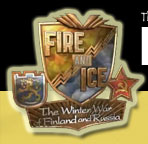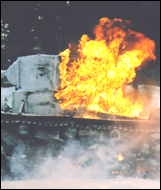

Molotov Cocktail's Role in the Winter War
Vyachislav Molotov, Stalin’s Minister of Foreign Affairs, did not see his name attached to the petrol bomb until December, 1939, during the early battles of the Winter War.
Molotov asserted during interviews on Radio Moscow, that the Soviet planes in the skies over Finland were dropping humanitarian supplies rather than bombs and the Red Army was attempting to liberate the Finnish people. The Finnish soldiers’ response to the lies was one of sardonic black humor: Soviet bombs were thereafter referred to as “Molotov’s Picnic Baskets”, and what more appropriate way to greet those masses of “liberating” tanks than with a Molotov cocktail? That’s how the legend goes, anyway.
As an explosive the Molotov cocktail is small potatoes. But, it
wasn’t the explosion that destroyed a targeted tank. What caused
the real, historical Molotov cocktail to be such a giant-slayer was
its near-perfect match with the tank’s own built-in Achilles ’ heel.
Most contemporary main battle tanks run on diesel fuel, which is too viscose
and has too high a kindling point to set on fire easily but, tanks of the World
War II era ran on petrol engines. And, since it was highly desirable for the
crews to be able to refuel their tanks as quickly as possible, many vehicles
were designed with fuel tanks high in the chassis and easily accessible, via
hinged fueling ports cut into the side armor panels or into the steel grille
covering the engine itself. This common design compromise permitted rapid refueling
under stressful conditions but, it also meant that a red-hot shell fragment,
or a tracer round fired at such close range that it was still glowing when
it struck, could easily touch-off the whole fuel supply, with highly unpleasant
consequences for the crewmen inside. Like fighter pilots, who also rode into
battle strapped to a large quantity of high-octane fuel, tank crews simply
learned how to not think about certain possibilities that came with their jobs.
Ironically, the same ventilation system that made it possible for a Molotov cocktail to penetrate the turret also protected the crew from another quieter but more insidious danger: the possibility of being asphyxiated by that silent, invisible assassin, carbon monoxide.
Most tank engines were installed behind and under the turret-ring – which meant that the toxic exhaust fumes tended to drift into the turret unless diverted away by mechanical means. Without a reliable exhaust/air-circulation system to expel the toxic fumes and bring in fresh air from outside, the turret would also turn into a steel coffin after about an hour.
Most of the exhaust fumes were carried away by a simple metal duct, not unlike the exhaust pipe on the family auto, but some amount of carbon monoxide inevitably seeped upwards and penetrated the turret, and the simplest, most efficient way of neutralizing that danger was to draw fresh air inside by means of a simple intake valve or a portal of some kind, augmented by small induction fans.
That was a World War II tank’s Achilles ’ heel – that portal
or chamber where the outside air interfaced with the stale, noxious air inside
the crew’s compartment; that was the bull’s eye that every tank-hunting
team aimed for with their petrol bombs. If a sufficient amount of flaming gasoline
got sucked into the turret, there was a good chance it would ignite one or
more rounds of ready ammo, which was usually stored in a rack near the main
gun’s breech. When that happened, the result was gruesome.
It was not the Molotov cocktail itself that caused the destruction of so many
tanks, but rather the secondary effects caused when its flames surged into
the turret. Hitting the targeted vehicle anywhere else would not produce decisive
results, but it could blind the crew with smoke and damage their eyes with
fumes. A certain per centage of Finnish cocktails contained tar, which would
produce black, reeking smoke and make it impossible for the tank’s machine-gunner
to draw a bead on the attackers.
In the tense period of diplomatic wrangling that preceded the outbreak of the Winter War, the Finnish government had clung to the illusion that its proclaimed policy of official neutrality would be enough to deter Soviet aggression. Its delegates told Stalin that Finland would resist the annexation, by force, of any Finnish territory, no matter which nation launched an aggressive action – the obvious reference here was to Hitler’s Germany.
But Stalin didn’t believe the Finns. Finland had welcomed German army
units into the nation once before, at the turning point in the Civil War of
1918. What was to prevent it from doing so again? And even if the Finns’ assertion
of neutrality were sincere, Molotov questioned how long and how effective the
Finnish resistance would be against the German armed forces. He reiterated
that Finland would not be allowed to stay neutral.
By the late summer 1939, the Soviets had put their cards on the table. Finland’s
government finally woke up to the fact that its army was in no condition to
fight. Funds were allocated for the modernization of the armed forces, a process
which, in most countries, required at least 18 months to be effective. Finland
had just 18 weeks.
Given the advanced state of mechanization in the Red Army, the Finn’s most glaring weakness was their lack of anti-tank weapons. Even with Stalin openly threatening annexation by force, the Finnish government engaged in protracted debates and leisurely, routine field tests to decide what type of anti-tank cannon to adopt.
Finally, the decision was made to purchase the sleek, maneuverable 37 mm. Bofors A/T cannon from Sweden (the very weapon Mannerheim had advised the Finns to buy, in large numbers, six months earlier), but by the time the contracts were signed, it was obvious that a Soviet attack was imminent. Railway bottlenecks complicated delivery; many of the first batch of Bofors guns arrived without sights or maintenance kits, and the Swedish training manuals had to be translated immediately. Most of the first gun crews trained on wooden mock-ups and did not even see a real, operational gun until just before they saw their first real Soviet tanks. By November 31, when the first bombs rained down on Helsinki, there were only two Bofors guns per regiment.
In those locations where the Finns enjoyed Bofors-gun support, the Swedish cannon immediately proved its worth. At ranges of 500 meters or less, its shells could penetrate the armor of any enemy tank. But there simply weren’t enough of them to go around. Relatively few Finnish soldiers even saw a Bofors gun, much less enjoyed the support of one.
It would be hard to exaggerate the psychological effect of those
Soviet tanks on soldiers in the path of an entire armored battalion.
Mortar shells bounced
off their turrets; hand grenades barely scratched the paint; anti-tank mines
were in critically short supply and positioning them in front of a moving vehicle
was an action that required near-suicidal courage and exquisite timing.
Mannerheim’s headquarters was deluged with pleas for more Bofors guns,
more field artillery and more satchel charges. All of those things were in
desperately short supply, and when headquarters did reply to the frontline
units’ pleas, the message was the same, hour after hour: You have your
order! Stay in your trenches and repel the Red infantry! New anti-tank weapons
are on their way to you now!
And while the radio crackled with panic and terror, truck after supply truck was pulling into the clearings near a distribution site in the small town of Rajamaki, where an anonymous bureaucratic-looking building had suddenly become the most vital strategic target in Finland. If the Soviet bomber pilots had it marked on their maps, it was identified as the State Central Liquor Factory (its peacetime designation) and not the Center for Anti-Tank Research and Development, which was its new unofficial title.
Kuitinnen & the Molotov Cocktail
When the diplomatic
talks showed signs of collapsing in mid-October, Mannerheim had ordered
the formation a contingency
planning board,
comprising some of
the army’s best experts in the field of tank and anti-tank technology.
As Chairman of this ad-hoc panel, he appointed Capt. Eero Kuitinnen, an ordnance
specialist commanding a company of elite Border Guard Pioneers. Kuittinen’s
soldiers spent a lot of time focusing on a range of tactical options that might
be effective if they were called upon to block the advance of a Soviet mechanized
column in the forest north of Lake Ladoga, but what if the invader tried different
combinations of units, from multiple directions? Nothing could be taken for
granted. Despite the recent purges, Stalin’s Red Army had shown itself
to be progressive in terms of weapons and support techniques.
Working with minimal funds and under enormous pressures of time and circumstance, Kuittinen and his Pioneers wrote the manual as they went along, working under the code name Pioneer Technical and Feasibility Study Number One. For a weapon with exactly one moving part – the fuse – the new mass-production anti-tank missile proved to be far from simple. What size should the bottle be? What ingredients, and in what proportions, should go into the payload? What was the best and most reliable material to use for the fuse? Was it better to douse the target with a shower of bombs and then ignite it, or to toss missiles sequentially at one specific vulnerable weak spot on the tank? Did the T-28 have any weak spots?
Kuittinen’s itemized list contained a surprisingly detailed list of topics for such a primitive device:
What sort of glass container was ideal? (It had to be large enough to hold an effective payload, yet compact enough to fit in a gloved hand; stout enough to resist a lot of casual rough handling, yet frangible enough to shatter completely with one hard impact);
It should utilize a cap or stopper that was quick to remove and re-fasten, yet reliably leak-free;
Would the detonation be more effective if the bottle was completely filled, or only half-way filled? Two-thirds filled? No one had ever systematically studied this aspect before, and now it had to be done on a crash priority basis;
What liquids or mixture of liquids was ideal for the basic content; what added ingredients, and in what proportions, would improve the lethality of a hit?
What was the ideal material for a fuse? Length? How much time did the bottle-thrower have between the moment he soaked the fuse and the moment when evaporation rendered the fuse ineffective or too dangerous to be worth the risk of a man’s life?
All, or at least the majority, of these questions, were about to be answered, starting on the gray, frigid afternoon of December 3, 1939.
All day long, rumors circulated through the Finnish frontlines about the eminent arrival of a new “miracle weapon,” one specifically designed to give them a fighting chance against those hordes of Red vehicles. Both hopes and speculation were almost out-of-control. As one old veteran later recalled in 1965, “One of my platoon mates had been reading too many Buck Rogers comics and he kept babbling about ‘death rays’ and ‘disintegrator beams!’ Imagine the look on his face when a supply truck pulled up at our command post, and when the tarp was pulled off of the cargo area, we saw only a big pile of crates filled with … vodka bottles. A whole stack of wooden crates marked ‘top secret’ and inside each crate, cradled in a thick layer of straw, were a half-dozen vodka bottles, with long rags dangling from the mouth, filled with some kind of greasy-looking but basically clear liquid. Our optimism crumbled. Whatever was in those bottles, it was obvious that we would have to get awfully close to an enemy tank before we could throw one with any chance of success.”
Getting close to the tanks proved to be much easier than expected. Like their Spanish counterparts three years earlier, these Soviet tankers surged ahead of the infantry platoons designated to be their escorts. Aided greatly by their ski-mobility, the Finnish tank-destroyer teams often managed to get within touching distance of their targets, and were able to throw their missiles straight into the steel grilles covering their engine compartments, often with dramatic results.
Word spread swiftly through the front lines. Not only did the Molotov cocktails work as advertised, but the enemy’s clumsy tactics made it relatively safe to approach an armored probe, deliver an accurate salvo of bombs, then retire into the cover of the nearby trees, all without being fired upon accurately in return. By nightfall of that first day, an estimated 40 Soviet tanks and other tracked vehicles had been blasted into smoldering wrecks throughout the center of the Mannerheim Line. And in the narrow lanes of Summa village, the lynchpin of all Finnish defenses in the sector, six KV heavy tanks were destroyed. Finnish morale soared. Soviet morale plummeted.
By the time the first Soviet offensive against the Summa ended, Kuittinen and his team had more than enough field data to finalize their design parameters. As it turned out, the best all-around bottle tested was, in fact, the one produced right there at the State Liquor Factory, the one liter vodka bottle; the screw cap worked well, too, secure enough to keep a tight seal, yet easily turned when the time came to insert a fuse. Depending on the mixture of combustible liquids inside, a fill-ratio of one-half to two-thirds (liquid vs. empty space) generally worked best. By adding tar, the basic bomb also became a noxious smoke grenade – useful to suppress enemy observation. At first, the cigarette lighter was the most common form of ignition, but that still meant that at some point, the bomb-thrower had to sit motionless for a few seconds, making vulnerable to enemy fire. One of Kuittinen’s team came up with the idea of affixing to the bottle itself a small ampoule of sulfuric acid – which self-ignites when exposed to oxygen.
During the approximately 115 days it was operational, Kuittinen’s factory made a contribution to Finland’s defense out of proportion to its size and visibility. Working brutally long hours, 87 women and five men hand-crafted 542,194 Molotov cocktails, apparently without a single dangerous mishap or injury. And their product is credited with destroying approximately 350 Soviet tanks and other vehicles.





